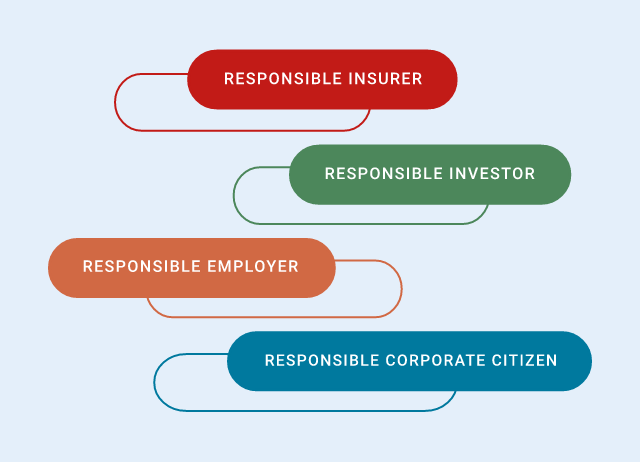Data and performance
Download
* Indicators reported within the Consolidated Non-Financial Statement subject to limited assurance by the external auditor.
Responsible investor
Responsible investor
| 2024 | 2023 | 2022 | |
| New green and sustainable investments (€ mln)* The amounts are cumulative (2021-2024). The figures for 2022 and 2023 have been updated to provide the cumulative data. |
13,921 | 9,126 | 5,727 |
| Fenice 190 - investments to support sustainable recovery in Europe (€ mln)* The amounts are cumulative (2020-2024). |
3,656 | 2,666 | 2,080 |
| Absolute emissions (mln tCO2e)* The indicator refers to the carbon footprint of direct investment portfolio of the Group’s insurance companies in listed equities and corporate bonds. The coverage is 75% for the years 2022 and 2023, and 88% for the year 2024. |
8.1 | 6.8 | 6.8 |
| Carbon intensity (EVIC) (tCO2e/€ mln invested)* The indicator refers to the carbon footprint of direct investment portfolio of the Group’s insurance companies in listed equities and corporate bonds, in terms of carbon intensity (EVIC). The coverage is 75% for the years 2022 and 2023, and 88% for the year 2024. |
89 | 98 | 100 |
| Carbon intensity (Sales) (tCO2e/€ mln invested)* The indicator refers to the carbon footprint of direct investment portfolio of the Group’s insurance companies in listed equities and corporate bonds, in terms of carbon intensity (sales). The coverage is 88% for the year 2022, 92% for the year 2023, and 89% for the year 2024. |
151 | 147 | 188 |
| Direct investments in listed equities and corporate bonds (€ bln)* | 102.1 | 92 | 91 |
To calculate the carbon footprint indicators, the Group relies on MSCI data. Data related to CO2 emissions and carbon intensity (EVIC and sales) of the companies in the portfolio refer to the last available data at the moment of the calculation of carbon footprint for this reporting (usually January/February of each year) and therefore mainly refer to the previous year as the new data are available in the second semester of the year.
Responsible insurer
Responsible insurer
| 2024 | 2023 | 2022 | |
| Premiums from insurance solutions with ESG components (€ mln)* | 25,193 | 20,815 | 19,868 |
| Premiums from insurance solutions with ESG components - social sphere (€ mln)* |
22,373 | 18,228 | 17,449 |
| Premiums from insurance solutions with ESG components - environmental sphere (€ mln)* | 2,820 | 2,587 | 2,419 |
| Customers (mln)* The number of customers refers to either a physical person or a legal entity that holds at least one active insurance policy and pays a premium to Generali accordingly, a banking product or a pension fund product. |
71 | 70 | 68 |
| Number of agents (thousand)* The number of agents refers to sales force within traditional distribution networks. |
161 | 164 | 161 |
| Relationship NPS* The Relationship Net Promoter Score (RNPS) is an indicator based on customer research data and calculated deducting the percentage of detractors from the percentage of promoters. The RNPS is expressed as an absolute number. The indicator spans 23 markets where we operate under the Generali brand: Argentina, Austria, Bulgaria, Croatia, Czech Republic, France, Germany, Greece, Hungary, India, Indonesia, Italy, Malaysia, Poland, Romania, Serbia, Slovakia, Slovenia, Spain, Switzerland, Thailand, Turkey and Vietnam. |
22.4 | 21.5 | 18.2 |
Responsible employer
Employees
Due to changes in the calculation method of some KPIs following the introduction of the CSRD reporting requirements, the 2024 data is not fully comparable with that of previous years' data, and therefore they have not been included.
Employees*
| 2024 | |
| Total Generali Group | 86,851 |
| of which Male | 41,545 |
| of which Female | 45,304 |
| of which Other | 2 |
| of which Not reported | 0 |
Employees per Region*
| 2024 | |
| Europe | 68,310 |
| Asia Pacific & Middle East | 13,787 |
| Latin America | 3,314 |
| North America | 1,440 |
| Total Generali Group | 86,851 |
Employees by level*
| 2024 | |
| Managers | 2,506 |
| Middle Managers | 13,164 |
| Employees | 52,855 |
| Sales attendant | 18,190 |
| Other | 136 |
| Total Generali Group | 86,851 |
Employees by age group*
| 2024 | |
| Under 30 years old | 11,303 |
| Between 30 and 50 years old | 50,437 |
| Over 50 years old | 25,111 |
| Total Generali Group | 86,851 |
Employment
| 2024 | |
| Permanent employees* | 81,324 |
| Temporary employees* | 5,511 |
| Non-guaranteed hours employees* Non-guaranteed hours employees are employed by the Group without a guarantee of a minimum or fixed number of working hours. |
16 |
| Full-time employees | 76,578 |
| Part-time employees | 10,273 |
| Employees hired | 14,505 |
| of which under 30 years old | 6,046 |
| of which between 30 and 50 years old | 7,516 |
| of which over 50 years old | 943 |
| Female Employees hired | 7,492 |
| Employees turnover (1) | 12,597 |
| Turnover rate (%)* (1) | 14.5 |
| Voluntary turnover rate (%) | 8.8 |
| Employees covered by collective bargaining agreements (%)* | 67.9 |
| Workers represented in the European Works Council (%) | 74 |
(1) Starting from 2024, figures are computed according to methodology and guidelines aligned with CSRD reporting standards for all legal entities.
Diversity, Equity & Inclusion
| 2024 | |
| Women on Board of Directors (%) | 46.2 |
| Female in top-executive position (%) In the Group Management Committee. |
20 |
| Women in strategic positions (%)* The indicator refers to the percentage of women in strategic positions out of the total number of strategic positions, defined as those in Group Management Committee (GMC), Generali Leadership Group, and their direct reports. For Generali Investments Holding and Banca Generali, the indicator takes into consideration the leadership positions (and their direct reports) as defined by the compensation policy and/or internal documentation. |
38.6 |
|
Women in managerial positions (%) |
40.4 |
|
Female employees (%)* |
52.2 |
|
Permanent female employees (% on total permanent employees) |
51.6 |
|
Gender Pay Parity Gap (%)* |
14.2 |
| Equal pay gap (%)* The Equal Pay Gap measures the pay gap between males and females performing the same work or work of equal value, accounting for gender-neutral, objective factors of salary differentiation. |
0.35 |
| Accessibility gap to variable remuneration between males and females (%)* The Accessibility gap to variable remuneration between males and females represents the percentage difference between males and females accessing variable remuneration across the entire organization. |
0.6 |
| Persons with disabilities amongst employees (%) In calculating this indicator, the number of employees with disabilities is defined in accordance with the definition of disability established by local national laws. Therefore, the disclosure of this information in certain countries where the Group operates may be subject to legal restrictions or limitations on data collection (i.e. the United States). The percentage is based on the employees’ headcount out of the total Group workforce. |
3 |
Training, Engagement and Performance
| 2024 | |
|
Training Investment (€ mln)* |
62.5 |
| Average hours of training per capita* The indicator refers to consolidated line-by-line companies, excluding a few limited exceptions due to business or local context peculiarities. They represent 99.8% of total employees. |
32.7 |
| Trained employees (%)* The trained employees represent 99.8% of the total, excluding a few limited exceptions due to business or local context peculiarities. |
100 |
| Upskilled employees (%)* | 84 |
| Employee engagement rate (%)* This index is calculated as the average of the results of six specific questions in the Group survey and it is a measure that summarizes employees’ belief in the company’s goals and objectives (rational connection), their sense of pride from working at Generali (emotional connection), and their willingness to go the extra mile to support the company’s success (behavioral connection). |
83 |
| Employees receiving regular performance and career development reviews (%)* Data refers to eligible employees (excluding fixed term contracts, new hired not entering the process, employees on long term leave, etc.). |
95.6 |
Hybrid Work
| 2024 | |
| Entities working Hybrid (%)* The indicator refers to fully consolidated companies, with some limited exclusions due to business peculiarities and local context specificities. |
100 |
Health and Safety
| 2024 | |
| Absenteeism rate (%) | 4.1 |
| Percentage of employees who are covered by health and safety management system* | 100 |
| Number of fatalities as result of work-related injuries and work-related ill health* | 1 |
| Number of recordable work-related accidents* (2) | 654 |
| Rate of recordable work-related accidents (by 1,000,000 working hours)* It is calculated as the number of work-related accidents divided by the total number of hours worked by our employees and multiplied by 1,000,000. In cases where it was not possible to directly calculate the number of hours worked, this number has been estimated on the basis of normal or standard hours of work, taking into account entitlements to periods of paid leave of absence from work (e.g., paid holidays, paid sick leave, holidays). |
4.7 |
(2) Figure computed according to methodology and guidelines aligned with CSRD reporting standards for all legal entities.
Group operations
Data refers to the scope of the Group Environmental Management System (EMS), which represents the following organizational units: Argentina, Austria, Bulgaria, Banca Generali, Chile, Croatia, Czech Republic, Europ Assistance, France, Germany, Greece, Hungary, Ireland, Italy, Malaysia, Romania, Poland, Portugal, Slovakia, Slovenia, Serbia, Spain, Switzerland and the UK. The growth of the reporting perimeter made it necessary to restate the entire trend from 2019.
GHG Emissions of own operation excluding agricultural and real estate businesses
|
|
2024 | 2023 | 2022 | Baseline 2019 |
|
Scope1 (tCO2e) (A) |
29,804 | 34,424 | 36,995 | 48,224 |
|
Scope2 - market based (tCO2e) (B) |
7,860 | 12,625 | 15,231 | 23,058 |
|
Scope2 - location based (tCO2e) |
48,967 | 50,310 | 55,519 | 73,419 |
|
Scope3 (tCO2e) (C) |
37,658 | 40,190 | 40,593 | 68,410 |
| Scope 3 - Purchased goods and services (tCO2e) [Cat. 1] | 4,810 | 5,455 | 5,951 | 10,800 |
| Scope 3 - Fuel-and-energy-related activities (not included in scope 1 or 2) (tCO2e) [Cat. 3] | 22,477 | 23,812 | 25,443 | 34,379 |
| Scope 3 - Waste generated in operations (tCO2e) [Cat. 5] | 1,022 | 1,033 | 752 | 1,318 |
| Scope 3 - Business travel (tCO2e) [Cat. 6] | 9,349 | 9,890 | 8,447 | 21,913 |
| Total emissions (tCO2e) (A+B+C)* | 75,322 | 87,239 | 92,819 | 139,692 |
Note: GHG emissions are calculated in accordance with the GHG Protocol - Corporate Accounting and Reporting Standard, represent 100% of the Group’s workforce linked to emission sources in operational control (88.4% measured and 11.6% extrapolated), and exclude the emissions of the agricultural business of the Leone Alato group and the real estate portfolio managed by GRE.
The measured data represent the following organisational units: Argentina, Austria, Bulgaria, Banca Generali, Chile, Croatia, Czech Republic, Europ Assistance, France, Germany, Greece, Hungary, Ireland, Italy, Malaysia, Romania, Poland, Portugal, Slovakia, Slovenia, Serbia, Spain, Switzerland and the UK. The GHG emissions of organisational units not included in this list have been extrapolated. The growth of the reporting perimeter (+2.6% in terms of the Group’s workforce compared to 2023) made it necessary to restate the entire trend from 2019. The gases included in the calculation are CO2, CH4 and N2O for combustion processes and all climate-altering gases reported in the IPCC AR4 for other emissions (long-lived greenhouse gases - LLGHGs). Scope 3 category 1 - Purchased goods and services includes paper purchase and water-related services, Scope 3 category 6 - Business travel includes air, train and private or rented car travels.
GHG Emissions from biofuels of own operation excluding agricultural and real estate businesses
|
|
2024 | 2023 | 2022 | 2019 |
|
Biogenic emissions (tCO2e) |
87 | 97 | 84 | 23 |
Note: the GHG emissions from biofuels are reported separately and are not included in the emissions data of the above tables, as stated by the GHG Protocol and exclude the emissions of the agricultural business of the Leone Alato group and the real estate portfolio managed by GRE.
Energy
|
|
2024 | 2023 | 2022 | 2019 |
|
Purchased electrical energy (GJ) |
346,413 | 366,607 | 409,057 | 545,325 |
|
Purchased renewable energy (%) |
94 | 87 | 85 | 79 |
|
Generation of renewable energy (GJ) |
587 | 681 | 654 | 400 |
|
District heating (GJ) |
109,159 | 121,296 | 133,769 | 159,782 |
|
District cooling (GJ) |
7,769 | 15,720 | 19,849 | 27,424 |
| Natural gas (GJ) | 61,708 | 70,453 | 91,066 | 119,680 |
| Natural gas consumed by trigeneration (GJ) | 139,861 | 186,334 | 184,217 | 200,341 |
| Diesel oil (GJ) | 114,287 | 139,952 | 148,880 | 247,221 |
| Gasoline (GJ) | 80,382 | 61,102 | 57,831 | 49,509 |
| LPG (GJ) | 5,011 | 5,898 | 5,899 | 5,323 |
| Biofuel (GJ) | 1,576 | 1,754 | 1,517 | 416 |
| Total energy (GJ) | 866,753 | 969,797 | 1,052,739 | 1,355,421 |
| of which non-renewable energy consumption (GJ) | 536,972 | 649,243 | 703,739 | 922,836 |
Note: energy data represent the organizational units listed above, covering the 88.4% of the Group employees. The growth of the reporting perimeter made it necessary to restate the entire trend from 2019. Diesel oil and gasoline include the fuel consumption of the company cars' fleet.
Mobility
|
|
2024 | 2023 | 2022 | 2019 |
| Private car (km) | 15,946,398 | 20,550,578 | 21,230,327 | 54,454,343 |
|
Airplane (km) |
44,141,045 | 43,192,558 | 28,868,445 | 81,669,603 |
|
Long-haul (%) |
27 | 31 | 33 | 24 |
|
Medium-haul (%) |
67 | 62 | 62 | 67 |
|
Short-haul (%) |
5 | 7 | 5 | 9 |
| Train (km) | 32,955,668 | 31,037,777 | 20,117,196 | 52,454,087 |
|
High-speed (%) |
83 | 84 | 81 | 81 |
|
Conventional (%) |
17 | 16 | 19 | 19 |
|
Total mobility (km) |
93,043,111 | 94,780,913 | 70,215,968 | 188,578,033 |
Note: mobility data represent the organizational units listed above, covering the 88.4% of the Group employees. The growth of the reporting perimeter made it necessary to restate the entire trend from 2019.
Other environmental data
|
|
2024 | 2023 | 2022 | 2019 |
|
Total water withdrawal (m3) |
503,497 | 717,401 | 684,246 | 962,512 |
| Total wastewater discharge (m3) | 503,497 | 717,401 | 684,246 | 962,512 |
|
Total waste production (ton) |
5,860 | 5,053 | 5,162 | 10,394 |
|
Waste for recycling (%) |
77 | 71 | 79 | 82 |
| Non-hazardous waste recycled (%) | 77 | 71 | 79 | 82 |
| Non-hazardous waste incinerated (%) | 6 | 8 | 5 | 7 |
| Non-hazardous waste sent to landfill (%) | 17 | 21 | 16 | 11 |
| Total hazardous waste (ton) | 24 | 43 | 71 | 411 |
| Hazardous waste (%) | 0.4 | 0.8 | 1.4 | 4 |
|
Total paper consumption (ton) |
3,647 | 4,174 | 4,555 | 8,282 |
|
Environmentally certified paper (%) |
80 | 84 | 82 | 59 |
Note: other environmental data represent the organizational units listed above, covering the 88.4% of the Group employees. The growth of the reporting perimeter made it necessary to restate the entire trend from 2019. The whole water withdrawal is for sanitary use, assumed consumption negligible.
Responsible Corporate Citizen
Responsible Corporate Citizen
|
|
2023 | 2022 | 2021 |
|
Funds allocated to the community (€ mln) |
16.8 | 14.5 | 13.9 |
|
of which The Human Safety Net (€ mln) |
12.6 | 9.4 | 10.1 |
|
Active countries for The Human Safety Net* |
26 | 26 | 24 |
|
Active partners for The Human Safety Net* |
85 | 77 | 77 |



